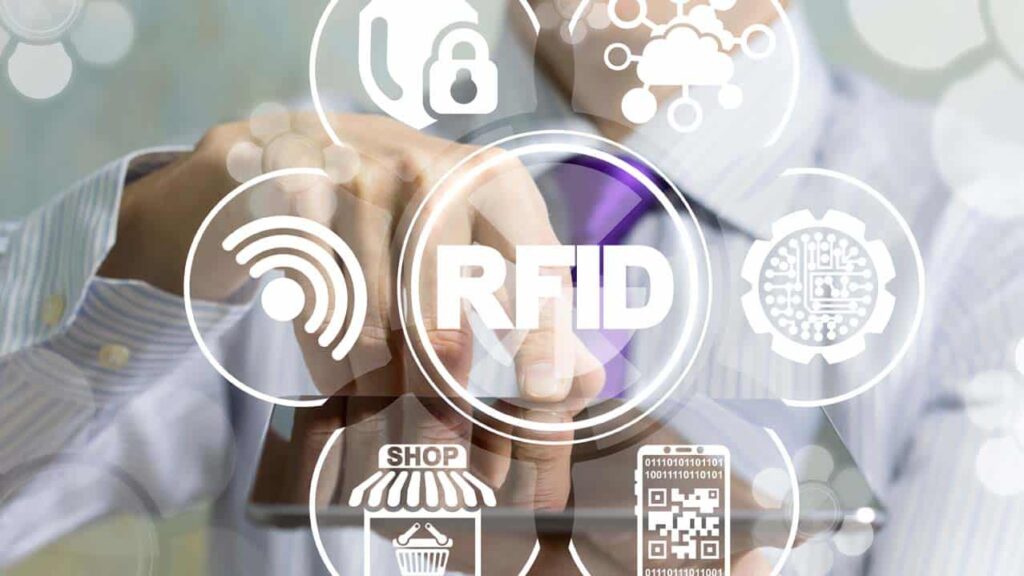For every retailer, inventory management can be a nightmare if it is not organized in the right way. To help you with this tedious task, we would like to talk to you about RFID (Radio Frequency Identification) technology. This type of system is used to identify products in an establishment through radio frequency waves. This enables all products in the warehouse to be tagged, identified and tracked.
What is RFID?
Broadly speaking, RFID technology identifies a reader, card or tag on a person or product, remotely, without the need for contact. A comparison could be made between RFID technology and a barcode. In the case of the latter, the code is read through an optical scanner, while with an RFID system the scanner uses radio waves and reads data from small chips that are called labels. The handheld rfid reader communicates with a tag and the tag transmits its information back to the reader. This information is sent by the reader to a database that can then be analyzed. Therefore, RFID technology uses radio frequency waves to automatically store and retrieve data through RFID tags.
What is and the operation of this technology is based on two types of devices: emitters and receivers. The receivers detect the signal of the emitters, which can be active or passive. The difference between the two lies in whether or not they have a power supply. The distance required for RFID technology to work is 1 to 10 meters and allows multiple items to be read simultaneously.
handheld rfid reader can be handheld scanners, door control access scanners, or mobile phones. For their part, the labels are small chips that are inserted in all kinds of objects, such as adhesive labels or smart cards that accompany the product.
What is RFID for?
Knowing how many products you have stored and where each of them is can seem complicated, but with RFID technology it is possible. These systems collect data on the products stored in an establishment by means of radiofrequency waves, generating reports from the collected data. This allows, in real-time, full knowledge and control over the products, inventories and assets of an establishment.
How can RFID help you in your retail business?
1. Product location
It is a very useful technology to prevent thefts from taking place since it allows you to follow all the store’s assets in real time and have them located. Likewise, it can be used to detect where items are located in a store and see which ones have been dislodged because they have been moved or, for example, because they are in the changing room.
2. Stock management
It is a very powerful system to manage inventory and control all the products in the warehouse. This will allow the retailer to avoid stockouts, since they will know at all times which products are selling the best and which ones are about to run out. In the same way, this technology will inform about which products are of least interest to the public and this will allow the retailer to know which ones to invest in.
3. Immediate and accurate identification
One of the key characteristics of RFID is its precision, it accurately locates any product or asset and this is very helpful when organizing large warehouses. To this must be added the immediacy, since it detects objects in real time.
what is rfid for
4. Time optimization
This technology saves a lot of time, preventing the retailer from having to review product by product. Instead, RFID performs a full scan in real time and with the highest possible accuracy of all inventory simultaneously. This technology speeds up the process of receiving, processing, replenishing and returning products, which translates into increased efficiency. Therefore, since the RFID system allows to carry out the inventory audit faster, the retailer can reinvest that time in other planning tasks.
5. Inventory control
By being able to identify the product without being in contact with it, inventory control becomes more exhaustive. In addition, the labels can be placed on any type of material (plastics, cardboard, wood …) which makes identification even easier.
6. Generation of knowledge
Once the RFID system carries out the analysis of the data, it can generate reports that serve so that the retailer knows all the details about the products that enter and leave their store, in such a way that they can use this information to take the most strategic decisions possible. What to buy and what to discard will no longer be an unanswered question.
rfid applications
In the past, this system involved a high investment, but today, with the decrease in technological costs, more and more companies are betting on this technology. In short, this system cannot bring more than benefits for your business, since it leads to an increase in the return on investment and, therefore, an increase in economic income. To begin with, you need to have a POS system that integrates with RFID to be able to test the advantages of this technology. Our recommendation is the Urovo that adapts to the Omni channel environment,
Currently, when offering personalized attention to the consumer is more important than ever, it is a sure success to take advantage of technologies like this to save time and be able to invest it in what really matters: the customer.

